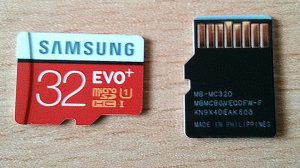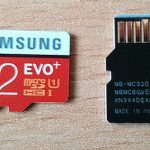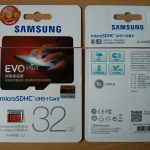My recent post on how to change the CID on a Samsung Evo Plus SD card has generated some interest, but also a number of people who are having problems with it. I thought it was worth posting an update with some extra information. First off, I suspect some people who are struggling have fake cards – there are a lot out there and some of them look pretty convincing. Others have suggested different hardware / firmware revisions might be an issue – quite possible but I have no way of knowing (all my Evo Plus cards work, so I can’t can’t compare against ones that don’t). I can see no reason why different phones etc. would give different results – as long as it’s a proper SD controller (not a USB mass storage adapter) then sending the command should work just fine.
Fake cards
These are very common and if you google for fake Samsung cards you’ll find lots of info on how to spot them. A few tip I’ve picked up along the way:
- Packaging quality – the image should be well printed, in high resolution and good bit depth on the colours (some fakes looks like they’ve been converted down to 256 colours). The gloss overlay over the printed areas should align with the printing below them, if it’s offset that’s a bad sign.
- Packaging info – the product information should be correct and match the card. I had one fake that incorrectly stated a 32gb card was SDXC on the pack instead of SDHC, the card itself had SDHC printed on it. The correct size should also be printed on the packet. Look up the UPC from the barcode on the back and make sure that matches the product and size of your card.
- Hologram, with scratch-to-reveal verification code. The real ones have them (recent ones at least), fakes might but probably don’t. All of mine have, but oddly enough when I tried to check one on the Samsung China website I didn’t get anywhere with the verification code, the site was in Chinese though so I might have been doing something wrong.
- The card – lots of subtle details to check. Smooth back, not lumpy showing circuit parts beneath the surface. Black on the back, white on the edges. Slight bevel on the contact side, to help insertion. Correct info printed on the card. Correct font, especially for the capacity digits, some fakes don’t use the correct slim font. Text on the back is printed so it is read with the card contacts end pointing upward. Mine are made in the Philippines but this is probably not the only place so don’t get hung up on this.
- Card CID – check it and compare to working ones. See below…
Card CID
An example of the CID on one of my cards: 1b 534d 3030303030 10 98625deb 0102 a1. Your card CID should be very similar. The manufacturer ID should be 1b, followed by an application/OEM ID of 534d. The product name is 3030303030 (5 x ASCII ‘0’). The product revision is 10 (1.0). The next 8 hex characters (98625deb) are the SD card serial number, yours will be different! The manufacturing date is next (0102, or 0 10 2), where the first digit is ignored, the next pair is the year in hex since 2000 and the last digit is the month in hex. So this is February (2) 2016 (2000 + 0x10). I also have March 2016 (0103) cards that work fine. Last is the checksum (a1) which will be different on your card. I doubt many of the fakes have properly set Samsung CIDs so hopefully this is an easy way to tell.
My cards / System
Samsung Evo Plus 32gb. UPC: 8806086928410. Model: MB-MC32D. Model code: MB-MC32D/CN. Purchased from this listing on AliExpress. I am not affiliated with the seller and get no referral commission from this link. I also cannot guarantee that you’ll get working or even genuine cards, but I have purchased on two occasions from this seller and the cards have been genuine and worked with evoplus_cid.
I have used evoplus_cid on a Samsung Galaxy Tab 2 (10 inch, wifi model, p5110). The tablet is running CyanogenMod 13 unofficial from here.
evoplus_cid
I’ve made a couple of updates to evoplus_cid. If you supply a full 32 digit CID (and don’t apply a serial number modifier) it will be written as is without recalculation of the checksum. This was requested by a user for cards that apparently always had a checksum of 00. Although, I’ve got a laptop that always displays 00 for the checksum when showing the CID, so I wonder now if his cards really did need that! I’ve fixed a bug when compiling on 64bit Linux that could prevent the CID being written. I’ve also fixed a bug causing the displayed CID to include some extra ‘FF’s.
Pictures


